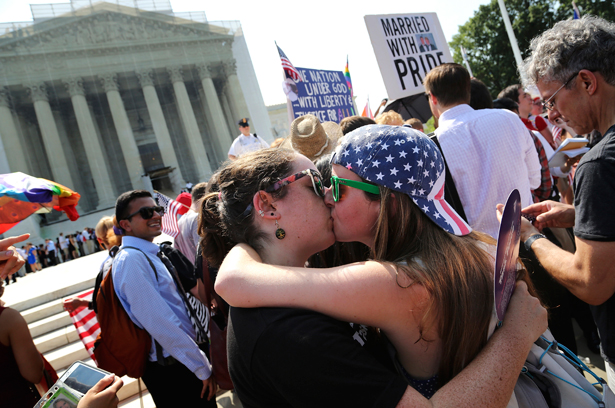
Sarah Beth Alcabes (L) kisses girlfriend Meghan Cleary, both of California, after the US Supreme Court’s ruling on cases against the federal Defense of Marriage Act (DOMA) and California’s gay marriage ban known as Prop 8, outside the Court in Washington, June 26, 2013. (REUTERS/Jonathan Ernst)
It was the best of weeks and the worst of weeks at the Supreme Court. Today the Court struck down a law that erased the marriages of same-sex couples from the benefits and burdens of all federal programs, and pulled the plug on efforts to keep a ban on gay marriages alive in California. These two decisions—especially the one on the so-called Defense of Marriage Act—took the Court to a new high in establishing formal equality under law regardless of sexual orientation. On Monday and Tuesday, however, the Court battered affirmative action, eviscerated the Voting Rights Act and added new obstacles to individuals who file anti-discrimination claims under Title VII.
Is this some new game of equality whiplash? Not really. For eight Justices, their views are consistent across the board. For the four most conservative Justices, the government is best that equalizes least. In fact, they see any affirmative attempt to dismantle hierarchy as presumptively unconstitutional and, even if adopted by a recent legislative majority, it will be tossed out as reflecting the attitudes of civil rights old-fogeyism. For the four progressive Justices, the current retrogression is horrifying. And then there’s that man in the middle.
Justice Kennedy must be deeply ambivalent about the meaning of equality. He blinked at the complete elimination of affirmative action programs in universities, stopping just short of that in his opinion for the Court in Fisher v. University of Texas. He joined the other conservatives in the Voting Rights Act and Title VII cases. And then he wrote the opinion in the DOMA case, one larded with aspiration and inspiration but short on doctrinal clarity. Equality has become such a shadowy presence in equal protection cases that Kennedy’s opinion insists that the material and dignitarian harms imposed by DOMA on a stigmatized minority probably should be traced to another portion of constitutional text. I’m sure that the five Justices who signed that opinion wrestled over how to word the sentences articulating this sort of new approach, but the result only proves the old adage about the perils of writing by committee.
What does all this mean?
For LGBT rights lawyers, who have worked for decades to follow in the footsteps of the civil rights movement and achieve formal equality, the day is bright. Formal equality looks damn good when you haven’t had it. True, we don’t know exactly whether formal equality for gays and lesbians will have the same doctrinal sheen that it has had for other minorities. It will be a while before we learn exactly how the Court is going to interpret the “equal liberty” doctrinal hybrid. Melding liberty and equality principles is not new. It has been a minor chord in earlier cases, but seemingly made its official debut in Windsor, the DOMA case. How far it’s going to migrate is anyone’s guess.
Popular
"swipe left below to view more authors"Swipe →
This is the third gay rights case in which, when one would have expected the Court to announce the level of stringency appropriate when courts review laws that classify based on sexual orientation, the Court has ducked. It seems quite likely that there are four votes for explicitly invoking the kind of heightened scrutiny applied to sex or race discrimination, so one has to assume that Justice Kennedy is not willing to go there. And since he has written all three of the feints (Romer v. Evans and Lawrence v. Texas before today), I would bet that he has decided to keep the gay rights legacy for himself, all the while using only a rational basis measure as a way to resist placing this form of discrimination on the same level with others.
Justice Kennedy’s jurisprudential hesitancy did nothing to mollify Justice Scalia, however. In what amounted to an off-the-charts level of invective for a Supreme Court Justice, Scalia berated the majority for a decision that was “rootless,” “shifting” and “high-handed,” motivated by a libeling of people like him as “enemies of the human race,” and characterized by “nonspecific hand-waving,” “real cheek,” “scattershot rationales [and] federalism noises” and—my favorite—“legalistic argle-bargle.” Although the majority opinion declares repeatedly its consistency with the traditional power of the states to regulate marriage, Scalia virtually screams that the logic of those arguments will eventually lead to invalidation of all restrictive state marriage laws. And he is, of course, right about that.
The legal debate over gay marriage has become kabuki, and the Scalias of the world are the losers in this drama. Another case calling the question for every state’s law will arrive at the Supreme Court soon. Today, in other words, is not the ultimate statement on whether marriage equality is constitutionally required, but no one doubts how this will end, if not in the next case, then in the one after that.
By contrast, for those fighting for a deeper meaning of equality, especially for the most subordinated minorities, the week is anything but bright. Formal equality looks pretty thin if that’s all you have.
Even though the myth that only rich white guys are gay has been repeatedly disproved by Williams Institute data, some part of the LGBT movement will almost certainly peel off when marriage equality finally becomes a fifty-state reality. Those demographic studies are true, however, and that means that most of us will still have a bundle of problems that formal equality won’t fix. Ever.
As the Supreme Court voted, huge crowds gathered outside the Court building in DC, anxiously awaiting the results.


